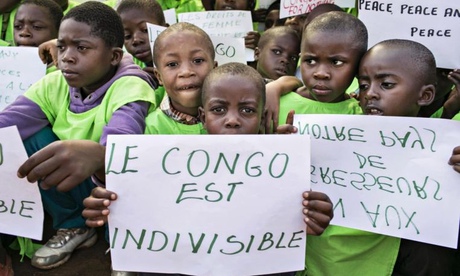Women's Rights & Issues
Related: About this forumSix innovations for ending violence against girls
Together for Girls crowdsourced a list of six strategies that are making progress towards ending gender-based violence

New campaigns, like this one for V-Day in the Democratic Republic of Congo, are engaging the whole community to end violence against women. Photograph: Reuters
On Valentine's day (V-Day) Together for Girls hosted a Twitter chat asking for innovate tactics that can end violence against women and children. The discussion revealed that approaches are evolving quickly. While services for survivors, like comprehensive post-rape care, are still lacking, the innovations we're seeing are focused on prevention efforts. Here are six of the best strategies suggested by the Twitterverse:
Engage communities holistically, not issue by issue
In the past, we've struggled with addressing violence when programmes only targeted potential victims of violence or focused too narrowly on single issues. Leading organisations today realise the importance of engaging whole communities in this work and focus on addressing the root causes of violence. Community needs, perspectives and voices are the starting point and central to the work.
Senegal-based NGO Tostan's community empowerment programmes spread awareness of human rights issues, including female genital mutilation, through social networks. In addition, Raising Voices produces activist kits to encourage communities to re-think and reshape social norms that underpin the use of violence.
Mentorship programmes for girls in and out of school
Mentorship programmes offered by organisations like the Lwala Community Alliance in Kenya not only help keep girls in school and encourage out of school girls to re-enroll, but they also empower girls to be self-advocates and provide safe spaces for girls to learn about issues such as reproductive health and gender-based violence.
Build healthy relationships
Several organisations are also helping girls to build healthy relationships that are rooted in power sharing. Additionally, boys are gaining the skills needed to sustain more equal relationships. Futures Without Violence equips athletic coaches with strategies to help build attitudes and behaviours among young male athletes that prevent relationship abuse.
Bring the men along
Increasing outreach to men and boys is now widely recognised as a critical component of any work to reduce violence and increase gender equality. New approaches that seem promising include parenting programmes that encourage men to be more engaged caregivers, such as MenCare's fatherhood campaign.
Use technology to break the silence
Current communications technology - from Twitter to online media libraries - allows use to share ideas and connect via campaigns such as One Billion Rising and Unicef's End Violence. Beyond Borders stages community-led radio dramas and Because I am a Girl creates empowering dance videos on YouTube. Adolescents in Haiti are using smart phones to map HIV issues. Sharing survivors' stories also helps influence policy and legislation, and demonstrates the possibilities of overcoming hardship and ending pervasive silence.
Collaborate
There is a need for strong partnerships between organizations and sectors to address the complexities of violence against girls, which (as a public-private partnership) Together for Girls strives to achieve. Bringing our different strengths together and sharing the lessons we're learning will help us to end the global pandemic of violence against women and children.
While not all of the innovations mentioned have been fully evaluated, we are excited and hopeful about the work being piloted and developed. Of course, to keep innovating, we must continue to listen to the voices of women and children and use data and research to understand what is worth expanding or refining, especially as we try to reach larger numbers of people.
http://www.theguardian.com/global-development-professionals-network/2014/mar/18/ending-violence-against-girls-together-programme
Joya Taft-Dick and Sandie Taylor are at Together for Girls. Follow @together4girls on Twitter.